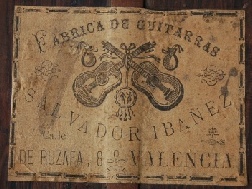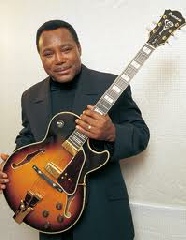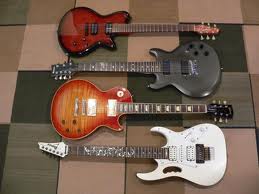


guitar market. Instead of investing resources into research and development, Ibanez began producing high quality, low priced copies of successful Hagstrom and EKO models. These guitars were exported to the U.S. and Europe and were well received. In 1965, the Hosino Gakki Company opened a United States distribution center in Bensalem, Pennsylvania. Hosino U.S.A. not only proved to be a major asset regarding distribution, but also became a main factor in quality control. Quality control was a major issue at this time because the top American companies were raising prices, cutting costs and dropping the overall
Ibanez Guitar History
Ibanez Guitars is an offspring of the Japanese bookstore company Hosino Gakki. Formed in 1908, Hosino Gakki originally sold sheet music and other musical products. In 1928 the company started importing and marketing a line of Spanish built acoustic guitars from the Ibanez Salvador Company.
When the Ibanez Salvador Company’s factory was destroyed during the 1930’s Spanish Civil War, Hosino Gakki bought the Ibanez Salvador name and in 1935 began manufacturing guitars in Nagoya, Japan. At that time, the name was shortened to “Ibanez”.
Ibanez Electric Guitars
In the 1950’s, with the emergence of Rock and Roll, Ibanez entered the electric

integrity of the instruments. Ibanez Guitars filled a void in the guitar market and was very successful selling low priced copies of expensive instruments. Although the Ibanez Guitars were made from cheaper materials, they were of high quality. Having a desirable clear bright tone, some models played and sounded better than the expensive name brand guitars they were modeled after. Many guitarists, who had been priced out of the market, could now afford a high quality, inexpensive copy of an expensive named brand instrument. As a result, Ibanez claimed a sizeable share of the electric guitar market throughout the U.S. and the world.
Having been successful at marketing copies of European guitars, in the early 1970’s,
Ibanez started reproducing the top selling designs of American companies such as
Gibson, Fender and Rickenbacker. At this time, Ibanez successfully entered the electric
bass guitar market with the neck-

copyright infringement lawsuit in June of 1977 concerning the Les Paul copies. In February 1978, Ibanez settled out of court. The Ibanez Branded Copy Era came to an end. This forced a change in the

Ibanez business model and the rest is history.
Ibanez Originals
Ibanez went to work in the research and development department. As a result, the Roadstar, Concert Series, SA, FA and the George Benson G.B. lines hit the market in

innovative Lee Ritenor LR10 was created. The LR10 was a double cutaway hollow body with a 24.75 inch scale and a set neck. It was constructed with a maple top, sides and back and the body was filled with a foam material. The foam filled body eliminated high volume feedback, common to hollow body electric guitars.
1978. Ibanez Guitars continued to expand their catalogue and the innovative Iceman Paul Stanley PS10 models were released the following year. The PS10 was followed by the Destroyer DT and Blazer series and in 1981 the
Since its inception, Ibanez has operated under a unique business model. While other prominent guitar manufacturers market their lower priced imports under another company name (Fender and Squier, Gibson and Epiphone), Ibanez markets every instrument they produce as an Ibanez. From the expensive Steve Vai JEMEVO to the inexpensive Roadstar Series, they are all sold under the Ibanez Guitar brand. Unlike Rickenbacker, who manipulates production and marketing to keep their instruments unaffordable to all but the economically well endowed, Ibanez provides an instrument line in every price range. Marketing affordable, innovative, high quality instruments is a proven formula that will undoubtedly successfully propel Ibanez into the future.


1980’s new wave, metal and grunge rock evolution. Rock legends Steve Vai, Joe Santriani, Paul Gilbert, Bob Weir, Paul Stanley and Adrian Smith have signature models in production and play Ibanez Guitars. Noted jazz players George Benson, Pat Metheny and John Scofield also have signature models.
Ibanez Guitars are regarded as a major component in the mid